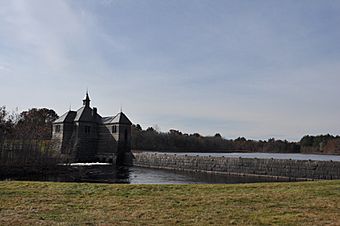Framingham Reservoir No. 1 Dam and Gatehouse facts for kids
Quick facts for kids |
|
|
Framingham Reservoir No. 1 Dam and Gatehouse
|
|
 |
|
| Location | Framingham, Massachusetts |
|---|---|
| Built | 1876 |
| Architect | George Albert Clough |
| MPS | Water Supply System of Metropolitan Boston MPS |
| NRHP reference No. | 89002291 |
| Added to NRHP | January 18, 1990 |
The Framingham Reservoir No. 1 Dam and Gatehouse is a special historical building in Framingham, Massachusetts. It's part of a system that used to help supply water to the city of Boston. This important complex is found at the end of Framingham Reservoir No. 1, also known as the Stearns Reservoir. It was built between 1876 and 1878. The famous architect George A. Clough designed it.
Contents
What is the Framingham Reservoir No. 1?
The reservoir was built where two parts of the Sudbury River met. Its main job was to control the river's water level. It also acted as a backup water supply. However, the bottom of this reservoir was muddy, so it wasn't the first choice for water. Reservoir No. 3, which was upstream, was preferred.
Even so, Reservoir No. 1 was very important. It helped manage the river's flow downstream. Its gatehouse was key for controlling water from all the Framingham reservoirs. This water could then go into the Sudbury Aqueduct.
Today, Reservoir No. 1 is not used as a main water source anymore. But it is still owned by the Massachusetts Water Resources Authority (MWRA). This group took over from the old Boston Water Board. The MWRA still owns it because the gatehouse connects Reservoir No. 3 to the Sudbury Aqueduct. These are still part of Boston's emergency water system.
How Does the Dam and Gatehouse Work?
The dam itself is about 793 feet (242 meters) long. It has a special overflow area that is 169 feet (51.5 meters) long. The sides of the dam are 20 feet (6 meters) wide. They have a strong core made of granite rocks set in cement. The top of the overflow area is made of cut granite. It used to have wooden boards that could be put up or taken down.
The gatehouse is a granite building with 1 and a half stories. It was designed by George Clough. It sits at the southern end of the overflow area. Inside, you'll find one end of the Sudbury Aqueduct extension pipe. This pipe comes from Farm Pond. There's also a 4-foot (1.2-meter) pipe that connects this reservoir to reservoirs numbers 2 and 3.
The gatehouse also has special gates. These gates allowed workers to choose where the water went. Water from any of the reservoirs (1, 2, or 3) could be sent into the Sudbury Aqueduct. Or, it could be sent into the river below the dam. There were also flood gates and tools to move the wooden boards on the dam.
Why is it Still Important Today?
Today, the gatehouse, the Sudbury Aqueduct, and the pipes from Reservoir No. 3 are still part of the MWRA's emergency water system. If there's an emergency, water from Reservoir No. 3 can flow through the Dam No. 1 gatehouse. It then goes down the Sudbury Aqueduct extension pipe to a gatehouse at Farm Pond. From there, it enters the main Sudbury Aqueduct. This aqueduct then carries the water all the way to the Chestnut Hill Reservoir.
A Historic Landmark
Because of its important history and design, the dam and gatehouse were added to the National Register of Historic Places in 1990. This means it's recognized as a special place worth protecting.



